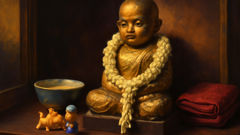Introduction
In a narrow sois of Bangkok and in the slow-moving lanes of provincial Isan, the song of devotion and the clink of tiny offerings stitch themselves into the afternoons. The Kuman Thong—literally “golden boy”—sits on lacquered shelves and altar plates like a secret kept in plain sight: a small effigy carved or molded to resemble a smiling child, gilded with leaf, wrapped in red cloth, and treated with the same rigor that households reserve for living relatives. To some, Kuman Thong is superstition; to others, a daily companion and talisman, summoned for luck in business, protection on journeys, and the blessing of children and prosperity. Its ritual life is intricate: incense lit at dawn, crushed milk poured into a tiny bowl, a lacquered toy left by its foot, whispered thanks for a profit earned or a debt repaid. The legend that surrounds the Kuman Thong weaves strands of folklore, devotion, and caution—stories told in quiet voices, half-lit by candlelight, that trace origins from ancient necromancy and monastic discipline to a more benign image of a protective sprite. In this layered telling, you’ll find the origins and variations of the Kuman Thong myth, the ethical and cultural tensions it raises, and one contemporary narrative that shows how belief, necessity, and respect converge when a family invites a Golden Boy into its home. The story aims to be both descriptive and careful: honoring the heartfelt practices of many Thai households while clarifying how ritual etiquette, community memory, and moral reflection shape the living tradition of the Kuman Thong.
Origins, Rituals, and Cultural Context
The story of Kuman Thong begins in the margins between magic and religion, where household needs meet ritual practice. Historically, accounts point to a mixture of folk belief, animism, and Buddhist-influenced practice that folded earlier Southeast Asian traditions into localized forms of ancestor devotion. The earliest literal interpretations of the Kuman Thong—ghostly children who favor the living—are entangled with complex rituals that borrowed language and structure from monastic necromancy and folk wisdom. Oral histories and folklore suggest that Kuman Thong first emerged as a way to contain grief and to translate the energies of the unseen into practical blessings. A child’s spirit, cared for through ritual, might become a guardian: an ambiguous notion that sits uneasily with modern religious sensibilities yet endures because it answers a very human need for protection and hope.

In household practice, the Kuman Thong is never simply an object; it is treated as a dependent being. If you walk into a Thai home where a Kuman Thong is venerated, you won’t see it ignored on a shelf. You will see small bowls of rice and milk, a fan to keep the figurine cool in scorching summers, and tiny offerings of toys or pencils if the household asks for help with the education of living children. The figurine may be an old, lacquered wooden carving, a mass-produced plaster statue painted in gold, or a modern amulet sized to fit a pocket. The red cloth often wrapped around a Kuman Thong has protective connotations; red is associated with power and auspiciousness in many Southeast Asian contexts. Offerings are given daily in many families: a pour of condensed milk, a crisp coin placed at the foot of the little seat, or freshly sliced fruit donated with a whisper of gratitude. These repeated gestures bind the living to the unseen in simple economies of care.
Ritual etiquette matters. The Kuman Thong is addressed gently, often by a given name chosen by the family or the monk who consecrated the figure. In some households, the Kuman Thong is invited formally by a ceremony, and a list of rules is recited: it is not to be abused, it must not be toyed with by disrespectful children, and it must be cared for before other, less-important rituals are performed. Disobedience to these rules, according to the lore, can bring misfortune. Yet the emphasis of many custodians is not fear but reciprocity: small gifts, small sacrifices, and consistent attention. The exchange is almost domestic—food for favor, attention for protection.
This reciprocity raises a set of ethical questions that Thai theologians, anthropologists, and lay practitioners still discuss. Some Buddhist practitioners discourage Kuman Thong practices, seeing them as a form of clinging that interferes with dispassion and the ethical precepts of non-harm. Others treat Kuman Thong as a cultural artifact containing lessons about social responsibility, rather than a literal spirit. Monks who perform Kuman Thong consecrations occupy a contested place: some are respected keepers of ritual expertise, while others are criticized for commercializing belief. The modern marketplace complicates the practice further: online sellers, amulet collectors, and touristic displays commodify a profound family tradition, and that commodification sometimes leads to sensational headlines, which in turn fuel moral panic or curiosity instead of understanding.
Regional variations enrich the Kuman Thong story. In Northern Thailand, rituals might include local charms and invocation forms drawn from Lanna culture; in the South, Malay influences color certain practices. The names given to Kuman Thong reflect local dialects and personal associations; sometimes they are named after relatives who died young, sometimes they’re given playful names to underscore their childlike aspect. The materials used to make a Kuman Thong—gold leaf, lacquer, aged wood, clay, or modern resins—tell another story about how tradition adapts to shifting economies. A gilded wooden child carefully carved and consecrated in a provincial monastery speaks to a slower, intergenerational devotion; a resin amulet bought in a city market and blessed for practical reasons speaks to urgent, modern needs.
Finally, the Kuman Thong serves as a lens for understanding how Thai people negotiate danger and desire. It sits at the crossroads of devotion and pragmatism. The figure promises small-scale interventions—success at a stall, a profitable day at the market, a safe return from travel—but it also demands moral reflection. Caregivers learn to treat the Kuman Thong responsibly, understanding that a petition for wealth must be balanced by generosity, and that the presence of the Golden Boy in a home reveals anxieties about security, legacy, and vulnerability. As such, the Kuman Thong legend is not only a story of spirits; it is a narrative about how communities make room for hope in uncertain times.
A Family's Tale: Respect, Fortune, and the Golden Boy
On the edge of a canal-lined neighborhood, where teak houses jutted out over water and morning mist rose like soft cloth off the surface, lived Ploy and her aging mother, Mae Sunee. Their grocery stall—half shop, half kitchen—had fed neighborhood kids on sticky rice and salted fish for decades. When Ploy took over the stall after her husband left for the city, she found herself juggling debts and customers with the same tired hands. Her mother prayed, of course, to the old Buddha image at the end of the lane. Ploy tried merit-making, and she went to the temple on festival days, but luck, she felt, had a stubborn mind. That was when a neighbor suggested quietly, and then more directly, that a little Kuman Thong might help. A local monk, the neighbor said, knew how to consecrate one properly—if Ploy was willing.

Ploy was skeptical, but she was not cruel. She remembered how her mother would rise at dawn to light incense at the altar and leave a bowl of coconut water for the neighbors’ spirits. It felt like asking for help with companionship rather than power. In exchange for a modest donation to the monastery, the monk presented a small gilded effigy, not more than the size of a teacup. He wrapped it gently in red cloth and murmured a list of dos and don’ts. The best advice, he said, was simple: treat the child like a family member. “If you show it respect, it will show you kindness,” the monk said. “If you forget, you may only find that your luck returns to you later, but that often comes with a price.” Ploy smiled politely, but inside she felt both relief and the quietly stern gaze of responsibility.
They named the Kuman Thong Noi—“Noi” meaning small—after a great-aunt who had died young and whom Mae Sunee always spoke of tenderly. The figure found its place on a lacquered shelf beside a faded photograph of Ploy’s father and a small bowl of rice left for ancestors each evening. Ploy began the ritual routines with a practical mind: a little milk every morning, incense in the afternoon, and a small toy pencil when the children in the neighborhood came by and asked for writing utensils. The customers noticed the change: sales that had been thin in the mornings thickened, and a regular customer who had been considering moving his laundry business elsewhere suddenly told Ploy he would stay. Money was never a torrent, and Ploy did not expect miracles, but there was a gentle improvement that she couldn’t quite name away.
As the weeks turned into months, the Kuman Thong became a conversation piece for aging regulars and a source of amusement for young boys who pressed their faces near the altar. Ploy kept it careful, and Mae Sunee made sure no child teased. When a neighboring vendor slipped and fractured a wrist, the Kuman Thong’s small presence inspired a communal visit: neighbors left tiny bundles of food and a thermos of hot tea. The shrine became, inadvertently, a magnet for social reciprocity. The small rituals—milk poured, incense lit—were excuses to gather, to exchange news, and to reassert a shared ethic of neighborliness.
But not all attention was benign. A traveling collector, hearing that a new Kuman Thong had arrived in the neighborhood, came with an offer to buy it. The offer was generous but made Ploy uncomfortable; the spiritual intimacy of their shrine felt like something not to be traded. When the collector persisted, bringing a small stack of notes and an impatient smile, Ploy refused. The collector left, but rumor swelled. Talk moved down the alleyways like a breeze, and some eyes suddenly measured Ploy’s stall for profit. She was later approached by a man who offered to sell charms for the Kuman Thong on consignment—promises of more customers and shortcuts to success. Ploy kept her hands steady at the counter and declined. She had seen the way devotion could be repackaged into commerce, and she did not want her family’s tiny domestic ritual to become a market gimmick.
The real test came on a rainy night when a storm flooded the alleyway and soaked the stall. Water rose to the threshold, and the family's ledger—years of careful columns—floated in warped sheets. Ploy spent the night wading in ankle-deep water, salvaging jars and goods, feeling the pressure of unpaid debts press in on all sides. In the morning, villagers stepped in with umbrellas, offered roof space, and awakened something Ploy had almost forgotten: community. The sermon at the neighborhood temple that morning was less about spirits and more about compassion, but when the customers returned, so did a small trickle of trade. And the Kuman Thong Noi, carefully wrapped and elevated on a wooden crate above the worst of the flood, had a tiny new garland around its shoulders, the work of a neighbor’s quick hands.
In the months that followed, Ploy thought often about the monk’s admonition that care must be reciprocal. She also learned that luck, while real if we measure it by everyday turns of fortune, is often braided to kindness. The Kuman Thong’s presence had not solved every problem, but it renewed a rhythm of care in the household: neighbors offered tasks, a child’s school fees were paid by a distant aunt after seeing how Ploy had been embarrassed earlier, and Mae Sunee’s health stabilized with renewed attention. Ploy never grew decadent with sudden wealth; she remained prudent and modest, and she would, in time, teach her own children the small rituals she hoped would instill responsibility and a sense of bound obligation.
Word travels differently in a small community than it does online. Some neighbors mocked, some asked for blessings; others kept their distance. Ploy’s decision to refuse commerce and commodification preserved the shrine’s intimacy. The Kuman Thong came to function as a social anchor: it required attention and, by doing so, made visible the moral economy of the street. It reminded people that blessings in that world were rarely solitary transactions; they were woven offerings that sometimes returned in time, often when one least expected them. The Golden Boy’s smile, small and sealed in lacquer and gold, taught Ploy less about magical shortcuts and more about the long practice of tending—tending to debts, tending to neighbors, tending to the fragile economies of a small life.
Conclusion
When a legend steps from temple grounds into living rooms, it changes shape. The Kuman Thong is at once a portable memory and a practical instrument: a symbol of care, an object of petition, and a pivot point for communal obligation. Across Thailand the Golden Boy continues to be both venerated and debated—cherished by families who feel its gentle effects and examined by scholars and religious leaders who wrestle with questions of ethics, commodification, and belief. For those who maintain a Kuman Thong shrine, the ritual is not about instant riches or untroubled living; it is about the daily act of tending and the moral contracts that emerge from it. To honor a Kuman Thong is to commit to a pattern of attention: milk poured each morning, incense lit in the afternoon, gratitude whispered in the evening. It is an old kind of domestic religion that compresses social ties into small, regular practices. The legend’s power lies not simply in supernatural promise but in how it reorders priorities, reminding households that care begets care and that luck, often, arrives on the back of steady, human devotion. In the end, the Golden Boy’s smile is less a guarantee than an invitation—an invitation to cultivate responsibility, generosity, and the quiet rituals that keep a family whole.













